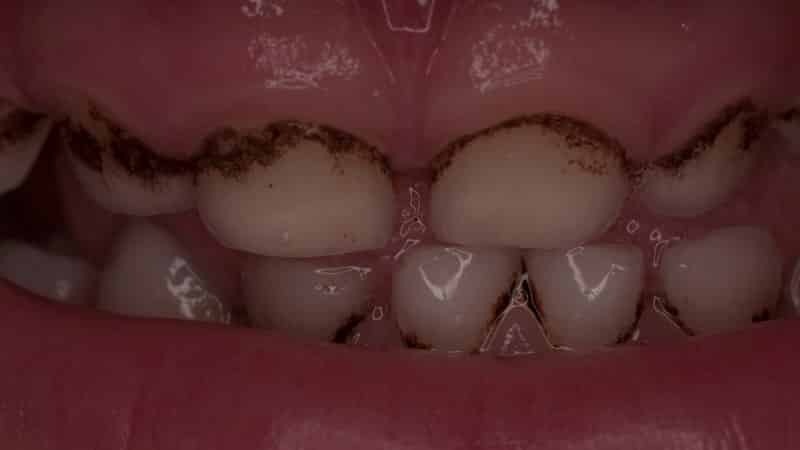Zobovje pri otrocih: simptomi, znaki, pogoji
Newborn babies are born without teeth.However, the program for the appearance of teeth in children: time and priority laid in the womb, with both baby teeth and permanent, that is, indigenous.
About five to six months, parents begin a fun time - the first milk teeth climb, they stubbornly punch their way.All would be nothing if the symptoms of teething in children were not similar to various diseases: from the common cold and cough to high fever and diarrhea.
Symptoms of teething
 The tooth does not erupt in a day or two.Especially since not one tooth comes out, but as many as twenty.It is important to recognize the symptoms and, if possible, to alleviate the pain as much as possible.
The tooth does not erupt in a day or two.Especially since not one tooth comes out, but as many as twenty.It is important to recognize the symptoms and, if possible, to alleviate the pain as much as possible.
Let's look first with the symptoms.They can be divided into two categories.The first category is the general symptoms that are common to most children.The second category is local or individual characteristics.
General characteristics of
Common symptoms may be evidence of colds, stress, or just the vagaries of toddlers.
- Actually, the whims themselves;
- Sharp mood swings - the child laughs, then immediately begins to whine without reason;
- Restless sleep in children day and night;
- Poor appetite and even refusal of food;
- Kroha tries everything she sees: from her mother's breast( he literally hangs on it, clutching her bare as yet gums) to rubber toys, spoons and even her own pens with fingers.
All these signs are associated with heavy salivation in children.In principle, first actively saliva is released, and then the baby begins to be capricious.Sometimes to the listed signs can be added a runny nose at teething - from a nose the water flows.So there is no cause for concern.As the rhinitis appears, when the first canines and the upper teeth are cut.
Local signs
If common signs can appear when teeth erupt, or may appear for other reasons, then local symptoms accurately indicate the first teeth.When you appear, for example, a runny nose when teething, you need to carefully examine and feel the gum - there should be redness and swelling on them.
After a certain time( in children it is different), through the pink gum the white tooth will be inserted and it can be fingered.
Controversial signs of teething
 It is often possible to hear the statements of parents and pediatricians that diarrhea with teething in children, like a rise in temperature, is a normal phenomenon.Yes, if the temperature does not rise above 38 or 38.5 degrees and does not last more than three days. Otherwise, it is already an infection. The body's temperature reacts to the inflammation of the gum and mucous membrane, but it should not be very high and prolonged.
It is often possible to hear the statements of parents and pediatricians that diarrhea with teething in children, like a rise in temperature, is a normal phenomenon.Yes, if the temperature does not rise above 38 or 38.5 degrees and does not last more than three days. Otherwise, it is already an infection. The body's temperature reacts to the inflammation of the gum and mucous membrane, but it should not be very high and prolonged.
As for diarrhea in teething - there may be some slight deviations in the stool, visible only to my mother.Remember, raising the temperature can also cause loosening of the stool.If diarrhea becomes permanent, you should consult a doctor.It is likely that some kind of intestinal infection has appeared, because the child pulls into his mouth horrible.Also refers to vomiting when teething - usually it should not be.By the way, cough with teething should not appear.Actually, as well as rhinitis snot with teething.
Features of teething
Why do some children get their first teeth cut faster and others slower.Dentists suggest that the cause is the speed of development of the root of the tooth, that is, in the rate of cell division( the root of the tooth, like any human organ, consists of cells).And it is impossible to accelerate this process artificially.So in any case, do not damage the gum or on purpose, do not cut it.Firstly, it is hellishly painful( remember how your wisdom teeth erupt).And secondly, so you can put the infection in the wound.Sooner or later the tooth will break through the bone tissue and the mucous membrane with its crown.
You can not speed up the process, but you can make it easier.The saliva itself contains enzymes that soften the mucous membrane.And natural antiseptics do not give infection to hit the tooth and gum.Let the kid chew special rubber teethers, crunches, bread crust, hard cookies, small bread - a crumb will not eat them as much as scratching them with an itchy gum.Do not forget to tie the bibs - remember the salivation.
How to ease the pain with teething
 Below is a list of measures to ease the pain when teething.Some of them can help, because all babies are unique.
Below is a list of measures to ease the pain when teething.Some of them can help, because all babies are unique.
- Teethers. Well-proven teethers, which need to be cooled - the cold soothes the inflamed gum.
- Massage. Dampen gauze swab in cold water and lightly brush the gum.Strongly do not press so as not to damage the shell.
- Rinse. If you can persuade your child and explain the procedure, rinse his mouth with infusions of medicinal herbs: lemon balm, chamomile, mint.You can use a syringe, give a drink to the broth, wipe the gums with the same gauze swab.
- Gels like Baby Denta , which contain anesthetic substances.The remedy is effective, but be careful.Frequent use of such drugs is addictive, and their effect is already ineffective.
Timing and sequence of teething
To say definitely, the code will cut through the first and subsequent teeth, hard.Every child is different.But the general, probable terms can be assumed.
- The first at the age of 6 or 8 months appear central teeth - lower incisors.There are two of them, and they can get out in turns, or they can both appear at once.
- Behind them in 8-10 months there are upper central incisors - also together or one by one.
- Next, the upper and lower lateral incisors erupt at the 9-12th month.
- Then after a year for the first 6 months, the first chewing teeth or molars appear - two at the bottom and the top.
- The most difficult teeth are fangs.They begin to erupt at about the 16th month and can grow up to three years.
At the age of three, there are 20 baby teeth in the child's mouth.

In order not to make mistakes in the timing of teething in children, you can print out a diagram or remember a formula that lasts up to two years.
In conclusion
 So, we will summarize the information.The most difficult thing is to overcome the appearance of the first teeth.Then it will be easier.
So, we will summarize the information.The most difficult thing is to overcome the appearance of the first teeth.Then it will be easier.
- The first teeth appear at 6, 7 or 8 months.
- Up to three years old, you have to get through and grow all 20 teeth.
- When the teeth have grown, you need to teach the child to properly brush their teeth and rinse their mouth after eating.
The most likely symptoms of teething.
- Bad sleep
- Minor and short-term temperature increase.
- Infrequent diarrhea due to teething due to fever.
- Bad appetite. ..
- Runny nose with teething is not a cold, but a clear water.
- Cough with teething can be.It causes the accumulation of saliva in the throat.
- Vomiting for teething is a rare case.It occurs, if at an elevated temperature you are against the will of the child tried to feed him.
What can not be:
- Snot with teething, as with a cold, should not be.It is worth remembering that at this age the immune system in children is weak and they can easily catch a cold, from where snot with a cough.
- The temperature should not last long.
- Stool disruption can not be prolonged.
Otherwise, trust pediatricians and internal maternal instincts.



